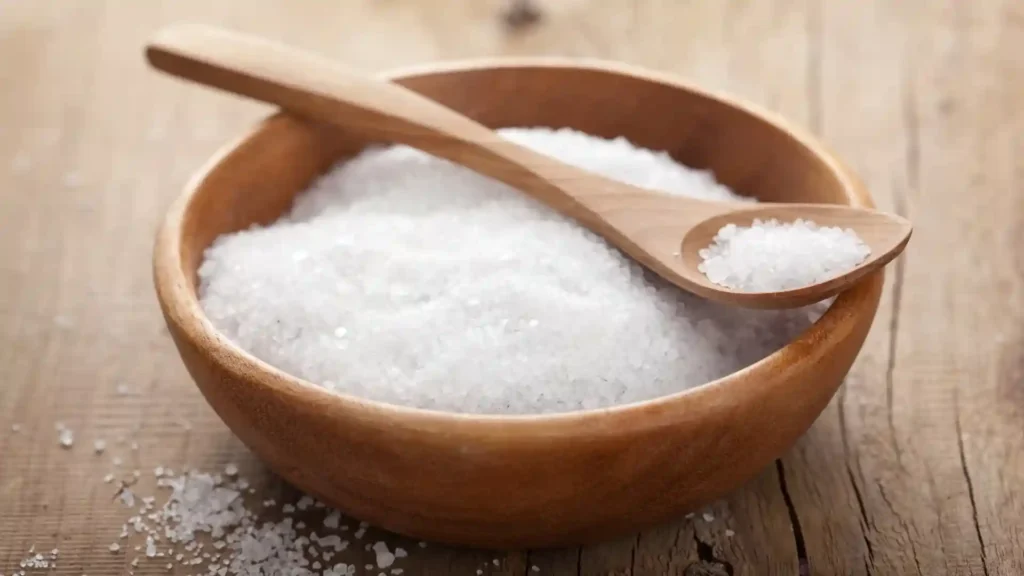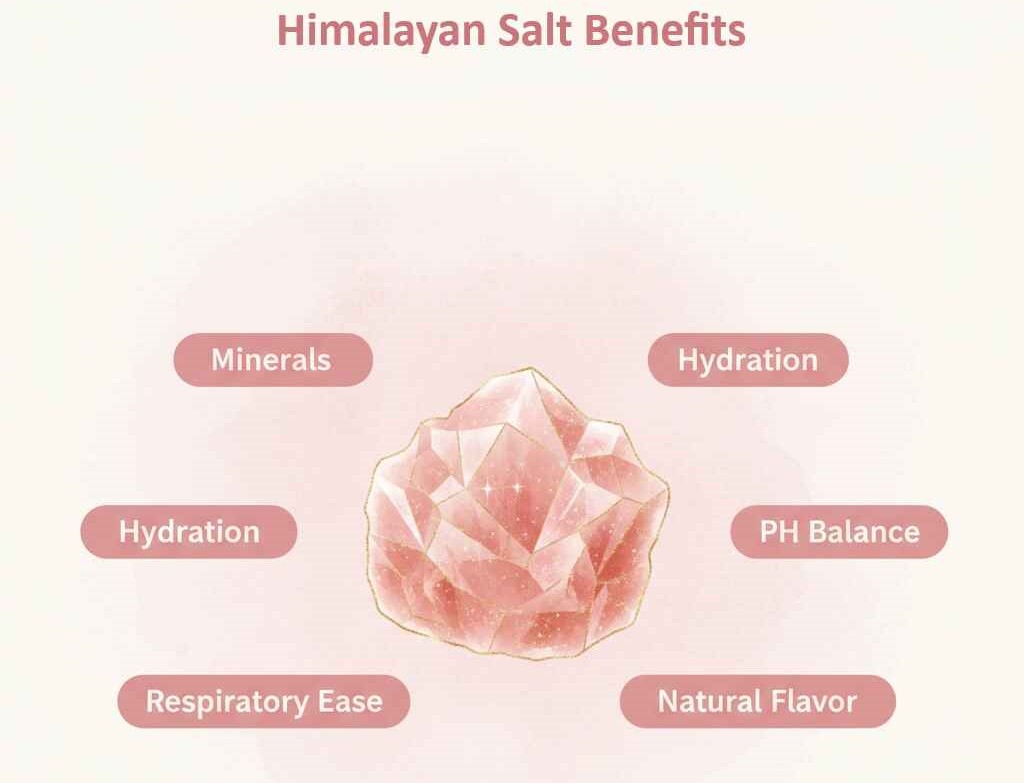Chinen Salt vs Himalayan Salt: What’s the Real Difference? (Expert Comparison)
- Zayan Rauf

Key takeaways
- Chinen salt is an herbal berberine-based extract, not a culinary salt, while Himalayan salt is a mineral-rich rock salt used for cooking and wellness.
- Himalayan salt contains 98% sodium chloride + 80+ trace minerals, supporting hydration, mineral balance, and natural flavor enhancement.
- Chinen salt offers targeted metabolic and blood sugar support due to berberine but requires professional guidance.
- The two are not interchangeable Himalayan salt suits everyday cooking and spa therapies, while Chinen salt works only as an herbal remedy.
- Choosing the right one depends on your goal: general wellness and seasoning (Himalayan) vs specific metabolic support (Chinen).
- Misidentifying Chinen salt as a culinary alternative can lead to misuse; understanding their roles ensures safer, informed decisions.
Distinguishing Chinen salt from Himalayan salt matters greatly, as confusion often arises despite their distinct roles. Himalayan salt serves as a versatile mineral-rich seasoning for cooking, wellness, and beauty routines, while Chinen salt acts as an herbal extract in traditional medicine, not a table salt alternative. Sobaan Salts delivers premium Himalayan salt options, underscoring the need to clarify these differences for informed choices in natural health practices.[1]

What Is Chinen Salt?
Chinen salt, rooted in traditional Chinese medicine, is an herbal preparation rather than a true salt for culinary use. It primarily features berberine, an alkaloid from plants like Coptis chinensis, valued for potential metabolic effects. Often misidentified as a salt substitute, its herbal nature demands caution to prevent misuse among those seeking natural remedies for blood sugar support or digestive aid.
Read More: Why Honey and Pink Himalayan Salt Are the Perfect Natural Remedy
What Is Himalayan Salt?
Himalayan salt, mined from Pakistan’s Khewra Salt Mine, is a pure rock salt celebrated for its pink hue from iron and other trace elements. Sobaan Salts provides high-grade versions in forms like fine grains, blocks for lamps, and bath soaks. Renowned for mineral diversity, it enhances meals subtly while promoting hydration and electrolyte equilibrium in daily wellness regimens worldwide.
Did You Know?
A clinical review shows berberine acts as a natural antimicrobial, supporting the gut by helping reduce harmful bacteria and improving digestive function.[8]
What Is Chinen Salt Made Of?
Chinen salt derives from botanical sources, not ancient deposits, with berberine as its core component from Coptis chinensis roots. This plant-based alkaloid supports targeted health applications, differing vastly from sodium-based salts. Users must recognize it as a supplement for metabolic concerns, not a flavor enhancer, to avoid errors in wellness routines focused on natural, plant-derived interventions.[2]
Himalayan Salt Composition
Comprising 98% sodium chloride, Himalayan salt includes over 80 trace minerals like magnesium, calcium, and potassium, contributing to its earthy taste and visual appeal. Studies confirm these elements’ presence, though in minor amounts, aiding its popularity in balanced diets. Sobaan Salts ensures unrefined purity, ideal for households prioritizing mineral intake without additives for cooking and therapeutic purposes.[3]
Uses: Cooking vs Herbal Remedy
Himalayan salt excels in versatile applications, from seasoning gourmet dishes to crafting air-purifying lamps and detox baths. It integrates seamlessly into spa therapies and electrolyte drinks for active lifestyles. Conversely, Chinen salt targets herbal protocols, such as berberine dosing for insulin sensitivity or gut health support. This divergence highlights why equating them overlooks their specialized functions in health strategies.[4]
- Everyday seasoning and meal prep
- Ambient lamps for relaxation
- Soothing bath soaks and scrubs
- Holistic spa treatments
Chinen salt applications include:
- Traditional metabolic tonics
- Berberine for glucose modulation
- Adjunctive herbal therapies
Himalayan Salt Benefits

Himalayan salt’s trace minerals foster electrolyte balance, supporting hydration during exercise or fasting. Its mild alkalinity may aid pH stability, while inhalation therapies from lamps benefit respiratory comfort.[5] Culinary uses elevate flavors naturally, and bath integrations promote skin detoxification. Trusted by wellness enthusiasts, Sobaan Salts’ products deliver these advantages without processing, enhancing daily vitality holistically.
- Essential mineral supplementation
- Optimal fluid and ion regulation
- pH equilibrium maintenance
- Respiratory support via halotherapy
- Subtle flavor enhancement
- Air quality improvement in homes
Chinen Salt Benefits
Berberine in Chinen salt shows promise in metabolic regulation, including lipid management and insulin response improvement per clinical overviews.[6] It suits targeted routines for chronic condition support, like dyslipidemia, rather than broad consumption. Not a salt replacement, its herbal profile demands professional guidance to maximize safety and efficacy in personalized wellness plans.
Key Differences: Chinen Salt vs Himalayan Salt
Feature | Chinen Salt | Himalayan Salt |
Origin | Plant extracts like Coptis | Ancient mine in Pakistan |
Type | Alkaloid herbal compound | Rock mineral salt |
Color | Powdery yellow-brown | Vibrant pink crystals |
Primary Use | Metabolic herbal aid | Culinary and wellness |
Composition | Berberine dominant | NaCl with 80+ traces |
Taste | Bitter, non-culinary | Savory, mineral-infused |
This table underscores their non-interchangeable natures, guiding selections based on intent herbal versus dietary.[7]
Did You Know?
A major study confirms that all salt types (including pink and herbal salts) contribute to hypertension when consumed in excess meaning moderation matters more than salt type.[9]
How They Compare in Taste and Use
Himalayan salt offers a nuanced, briny profile that complements ingredients without overpowering, perfect for gourmet finishing or brines. Chinen salt, lacking salinity, serves solely in decoctions for therapeutic dosing, not palates. Their divergence in application, one for sensory delight and the other for physiological modulation, clarifies selection for cooking enthusiasts versus supplement seekers in health optimization.
Which One Is Better for Health?
Health superiority hinges on context. Himalayan salt supports general mineral needs and hydration, making it safe for routine use. Chinen salt targets specific metabolic pathways through berberine, which can help with insulin-related issues but isn’t suitable for daily consumption. Neither one is universally better. Your choice should align with your goals, whether broad wellness or a focused intervention, to avoid misuse in dietary or supplemental contexts.
Read More: Exploring the Different Himalayan Salt Colors and Their Unique Properties
Which One Should You Choose?
Opt for Himalayan salt from Sobaan Salts for mineral-enriched cooking, home therapies, and electrolyte support in active lives. Its purity suits versatile integration. Reserve Chinen salt for berberine-specific needs under guidance, avoiding culinary swaps. Evaluate purpose flavorful seasoning or herbal targeting to ensure alignment with lifestyle demands for effective, confusion-free natural health incorporation.
Conclusion
Chinen salt and Himalayan salt diverge fundamentally. The former as a berberine herbal for metabolic precision, the latter as a mineral salt for culinary and ambient wellness. Sobaan Salts’ Himalayan offerings shine in everyday applications, while Chinen demands niche use. Grasping these distinctions empowers precise choices, fostering safe, tailored paths to enhanced vitality and informed natural living.
Chinen salt and Himalayan salt diverge fundamentally. The former as a berberine herbal for metabolic precision, the latter as a mineral salt for culinary and ambient wellness. Sobaan Salts’ Himalayan offerings shine in everyday applications, while Chinen demands niche use. Grasping these distinctions empowers precise choices, fostering safe, tailored paths to enhanced vitality and informed natural living.
References
- Li, Z., Wang, Q., Feng, B., Zhang, M., Liu, J., Wang, Y., Shi, J., Wang, X., Xu, L., & Gao, X. (2023). Berberine and health outcomes: PubMed
- Zhang, Q., Li, X., & Wang, Y. (2011). Preventive effect of Coptis chinensis and berberine on intestinal injury in rats challenged with lipopolysaccharides. Food and Chemical Toxicology, 49(1), 61–69.
- Fayet-Moore, F., McMahon, S., Beck, M., Callister, T., Collins, P., Wray, C., Duncanson, E., & Pendergast, P. (2020). An analysis of the mineral composition of pink salt available in Australia. Foods, 9(10), 1490.
- Cicero, A. F. G., & Baggioni, A. (2016). Berberine and its role in chronic disease. In Anti-inflammatory nutraceuticals and chronic diseases: Advances in experimental medicine and biology (Vol. 928, pp. 27–45). Springer International Publishing.
- Wasik, A. A., & Horowitz, R. I. (2021). Salt therapy as a complementary method for the treatment of respiratory tract diseases, with a focus on mold-related illness. Alternative Therapies in Health and Medicine, 27(S1), 223–239. (Publisher: InnoVision Health Media). PubMed
- Chander, V., Tewari, D., Kumar, A., Semwal, R. B., Semwal, D. K., Joshi, S. K., & Semwal, R. (2020). Structural characterization of Himalayan black rock salt by SEM, XRD and in-vitro antioxidant activity. Science of the Total Environment, 748, Article 141269.
- Xu, X., Yi, H., Wu, J., Kuang, T., Zhang, J., Li, Q., Du, H., Xu, T., Jiang, G., & Fan, G. (2021). Therapeutic effect of berberine on metabolic diseases: Both pharmacological data and clinical evidence. Biomedicine & Pharmacotherapy, 133, Article 110984.
- Habtemariam, S. (2020). Berberine and its role in chronic disease management: A review of therapeutic potential and mechanisms of action. Biomedicine & Pharmacotherapy, 127, 110–140.
- Huang, L., Trieu, K., Yoshimura, S., Neal, B., & Campbell, N. R. C. (2021). Effect of reduced salt intake on blood pressure: A systematic review and meta-analysis. The New England Journal of Medicine, 385(20), 1981–1995.
Share This Post
Article By

